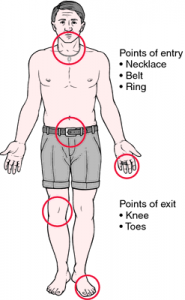Shocking! Moby gets Electrocuted

Singer Moby was “mildly electrocuted” by a hanging light fixture during a performance in Amsterdam. The 45 yr-old (born Richard Melville Hall) was promoting his new album and photography book both titled “Destroyed”, when he received an electrical shock to the neck from a hanging light bulb. He fainted shortly afterwards and seemed to be unconscious for at least 30 seconds. Afterwards, he still got up and performed. According to Moby on his website:
yes, i was mildly electrocuted during an acoustic show at the reflex gallery in Amsterdam. but i’m feeling a-ok now. maybe i even had some accidental electro shock therapy. thanks for your concern.
Here’s a video of the incident:
According to the Bureau of Labor Statistics, for the last decade, electrical injury has been responsible for an average of 320 deaths and over 4,000 injuries involving days away from work annually in the United States. It is the second leading cause of fatality in construction industry, and it consistently makes 5 to 6% of all occupational fatalities.
An electrical injury is damage to the skin or internal organs when a person comes into direct contact with an electrical current. The human body conducts electricity very well. That means, electricity passes very easily throughout the body. Direct contact with electrical current can be deadly. While some electrical burns look minor, there still may be serious internal damage, especially to the heart, muscles, or brain.
 Electric current can cause injury in three ways:
Electric current can cause injury in three ways:
- Cardiac arrest due to the electrical effect on the heart
- Muscle, nerve, and tissue destruction from a current passing through the body
- Thermal burns from contact with the electrical source
Causes
- Accidental contact with exposed parts of electrical appliances or wiring
- Flashing of electric arcs from high-voltage power lines
- Lightning
- Machinery or occupational-related exposures
- Young children biting or chewing on electrical cords, or poking metal objects into an electrical outlet
Symptoms
Symptoms depend on many things, including the type and strength of voltage, how long the contact with the electricity was, how it moved through the body, and the overall health of the victim. Symptoms may include:
- Changes in alertness (consciousness)
- Broken bones
- Heart attack
- Headache
- Problems with swallowing, vision, or hearing
- Irregular heartbeat
- Muscle spasms and pain
- Numbness or tingling
- Breathing problems or lung failure
- Seizures
- Skin burns
First Aid
1. If you can do so safely, turn off the electrical current. Unplug the cord, remove the fuse from the fuse box, or turn off the circuit breakers. Simply turning off an appliance may NOT stop the flow of electricity. Do NOT attempt to rescue a person near active high-voltage lines.
2. Call your local emergency number, such as 911.
3. If the current can’t be turned off, use a non-conducting object, such as a broom, chair, rug, or rubber doormat to push the person away from the source of the current. Do not use a wet or metal object. If possible, stand on something dry and that doesn’t conduct electricity, such as a rubber mat or folded newspapers.
4. Once the person is away from the source of electricity, check the person’s airway, breathing, and pulse. If either has stopped or seems dangerously slow or shallow, start first aid. (See: CPR)
5. If the person has a burn, remove any clothing that comes off easily, and rinse the burned area in cool running water until the pain subsides. Give first aid for burns.
6. If the person is faint, pale, or shows other signs of shock, lay him or her down, with the head slightly lower than the trunk of the body and the legs elevated, and cover him or her with a warm blanket or a coat.
7. Stay with the person until medical help arrives.
8. Electrical injury is frequently associated with explosions or falls that can cause additional severe injuries. You may not be able to notice all of them. Do not move the person’s head or neck if the spine may be injured.
If you witness someone being electrocuted, stay safe yourself-
- Stay at least 20 feet away from a person who is being electrocuted by high-voltage electrical current (such as power lines) until the power is turned off.
- Do NOT touch the person with your bare hands if they are still in contact with the source of electricity
- Do NOT apply ice, butter, ointments, medications, fluffy cotton dressings, or adhesive bandages to a burn
- Do NOT remove dead skin or break blisters if the person has been burned
- After the power is shut off, do NOT move the person unless there is a risk of fire or explosion
Prevention
- Avoid electrical hazards at home and at work. Always follow manufacturer’s safety instructions when using electrical appliances
- Avoid using electrical appliances while showering or wet
- Keep children away from electrical devices, especially those that are plugged in
- Keep electrical cords out of children’s reach
- Never touch electrical appliances while touching faucets or cold water pipes
- Teach children about the dangers of electricity
- Use child safety plugs in all outlets
For more information about electrical injuries, click here to go to the Resounding Health Casebook on the topic.



























0 comments